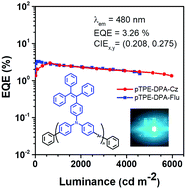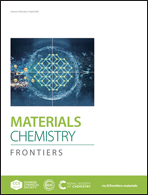Aggregation-induced emission polymers for high performance PLEDs with low efficiency roll-off†
Abstract
As the congener of organic light-emitting diodes, polymeric light-emitting diodes (PLEDs) possess a number of distinct merits, such as a low-cost wet fabrication process, which make them applicable in large-area flexible display and lighting fields. However, most emissive polymers used in PLEDs suffer from the aggregation-caused quenching (ACQ) effect, which makes the device show large efficiency roll-off. In this work, two polymers, pTPE-DPA-Cz and pTPE-DPA-Flu, featuring aggregation-induced emission (AIE) characteristics were facilely synthesized through Suzuki–Miyaura polycoupling reaction by incorporating the AIE unit of TPE-DPA in their main chains. The resultant polymers possess good film-forming ability, excellent thermal stability and high photoluminescence quantum yields (PLQYs) in their film states, facilitating the fabrication of PLEDs through a solution process. Indeed, the PLEDs using pTPE-DPA-Cz and pTPE-DPA-Flu as emitting layers (EMLs) could achieve a maximum external quantum efficiency (EQE) of 3.26% (doped EML) and current efficiency of 3.69 cd A−1 (non-doped EML). Notably, all the devices exhibit a quite low efficiency roll-off. This work indicates that AIE polymers are ideal candidates for the construction of high performance PLEDs with low efficiency roll-off.

- This article is part of the themed collection: Recent Progress on Aggregation-Induced Emission


 Please wait while we load your content...
Please wait while we load your content...